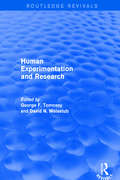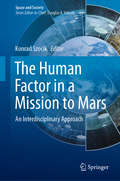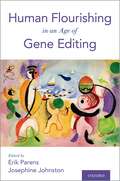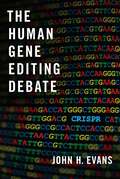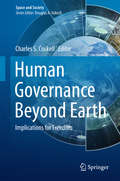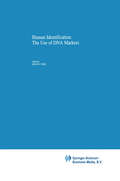- Table View
- List View
Human Experimentation and Research
by George F. Tomossy David N. WeisstubThis title was first published in 2003: As new medical technologies and treatments develop with increasing momentum, the legal and ethical implications of research involving human participants are being called into question as never before. Human Experimentation and Research explores the philosophical foundations of research ethics, ongoing regulatory dilemmas, and future challenges raised by the rapid globalisation and corporatisation of the research endeavour. This volume brings together some of the most significant published essays in the field. The editors also provide an informative introduction, summarizing the area and the relevance of the articles chosen.
Human Extinction: A History of the Science and Ethics of Annihilation (Routledge Studies in the History of Science, Technology and Medicine)
by Émile P. TorresThis volume traces the origins and evolution of the idea of human extinction, from the ancient Presocratics through contemporary work on "existential risks." Many leading intellectuals agree that the risk of human extinction this century may be higher than at any point in our 300,000-year history as a species. This book provides insight on the key questions that inform this discussion, including when humans began to worry about their own extinction and how the debate has changed over time. It establishes a new theoretical foundation for thinking about the ethics of our extinction, arguing that extinction would be very bad under most circumstances, although the outcome might be, on balance, good. Throughout the book, graphs, tables, and images further illustrate how human choices and attitudes about extinction have evolved in Western history. In its thorough examination of humanity’s past, this book also provides a starting point for understanding our future. Although accessible enough to be read by undergraduates, Human Extinction contains new and thought-provoking research that will benefit even established academic philosophers and historians.
Human Extinction: A History of the Science and Ethics of Annihilation (Routledge Studies in the History of Science, Technology and Medicine)
by Émile P. TorresThis volume traces the origins and evolution of the idea of human extinction, from the ancient Presocratics through contemporary work on "existential risks." Many leading intellectuals agree that the risk of human extinction this century may be higher than at any point in our 300,000-year history as a species. This book provides insight on the key questions that inform this discussion, including when humans began to worry about their own extinction and how the debate has changed over time. It establishes a new theoretical foundation for thinking about the ethics of our extinction, arguing that extinction would be very bad under most circumstances, although the outcome might be, on balance, good. Throughout the book, graphs, tables, and images further illustrate how human choices and attitudes about extinction have evolved in Western history. In its thorough examination of humanity’s past, this book also provides a starting point for understanding our future. Although accessible enough to be read by undergraduates, Human Extinction contains new and thought-provoking research that will benefit even established academic philosophers and historians.
The Human Face of Water Security (Water Security in a New World)
by David Devlaeminck Zafar Adeel Robert SandfordThis volume collects essays from academics and practitioners from a diversity of areas and perspectives in order to discuss water security at various levels and to illuminate the central idea of water security: its focus on the individual. Beginning with the big picture, this book aims to illustrate the depth of the water security crisis and its interconnections with other aspects of societal development. It particularly draws a connection to the 2030 Agenda for Sustainable Development, and discusses that challenges faced in meeting the 17 sustainability development goals (SDG) by the year 2030. Moving from international to domestic and community perspectives, this book provides a unique analysis of issues and solutions to the water issues we face today in light of the ever looming global changes brought on by climate change. Over the past few decades the recognition of our common need for water has increased, as policymakers have sought to place more focus on the individual within policy. After the recognition of water and sanitation as a fundamental human right by the United Nations General Assembly in 2010, there is increasing recognition of the individual as the building block for the struggle for water security. This reality also intersects with adverse impacts of global climate change, and the book responds to the broader question: will clean and safe water be available where we need it and when we need it in the future?
The Human Factor in a Mission to Mars: An Interdisciplinary Approach (Space and Society)
by Konrad SzocikA manned mission to Mars is faced with challenges and topics that may not be obvious but of great importance and challenging for such a mission. This is the first book that collects contributions from scholars in various fields, from astronomy and medicine, to theology and philosophy, addressing such topics. The discussion goes beyond medical and technological challenges of such a deep-space mission. The focus is on human nature, human emotions and biases in such a new environment.The primary audience for this book are all researchers interested in the human factor in a space mission including philosophers, social scientists, astronomers, and others. This volume will also be of high interest for a much wider audience like the non-academic world, or for students.
The Human Factor in Social Capital Management: The Owner-manager Perspective (Critical Studies on Corporate Responsibility, Governance and Sustainability #9)
by Paul C. Manning William Sun"This book is about the management of social capital processes as they are accomplished-understood, experienced and shaped-by owner-managers. The aim of the book is to develop a deeper understanding of these management processes, and thereby to contribute to a greater congruence between lived social capital perspectives and experiences, and theoretical and empirical literature. The book argues that social capital processes are context dependent and hence cannot be fully understood within an economic understanding of rationality. It follows that claims for the universality of the economic way of looking at life, and for looking at social capital processes are over-stated. Predicated on this insight the book investigates economic notions of rationality, as well as other perspectives on rationality in the management of social capital processes."
The Human Factor in the Settlement of the Moon: An Interdisciplinary Approach (Space and Society)
by Margaret Boone Rappaport Konrad SzocikApproaching the settlement of our Moon from a practical perspective, this book is well suited for space program planners. It addresses a variety of human factor topics involved in colonizing Earth's Moon, including: history, philosophy, science, engineering, agriculture, medicine, politics & policy, sociology, and anthropology. Each chapter identifies the complex, interdisciplinary issues of the human factor that arise in the early phases of settlement on the Moon. Besides practical issues, there is some emphasis placed on preserving, protecting, and experiencing the lunar environment across a broad range of occupations, from scientists to soldiers and engineers to construction workers. The book identifies utilitarian and visionary factors that shape human lives on the Moon. It offers recommendations for program planners in the government and commercial sectors and serves as a helpful resource for academic researchers. Together, the coauthors ask and attempt to answer: “How will lunar society be different?”
Human Factors and Patient Safety: A primer for doctors and medical students
by Ibrahim ImamThis book fulfils the need of doctors, medical students, and all healthcare personnel for information that addresses fundamental patient safety concepts that are not usually covered in conventional medical curricula.There are three valuable features. Firstly, the content encompasses the main areas of human factors and patient safety in short and easily accessible language supplemented by anecdotes from safety-critical industries such as aviation and nuclear power. Secondly, each chapter highlights the problems of human error and provides solutions that help to reduce the risks to patients. Finally, the coverage highlights the important role the public should play in protecting their own safety when in contact with healthcare systems.
Human Factors and Patient Safety: A primer for doctors and medical students
by Ibrahim ImamThis book fulfils the need of doctors, medical students, and all healthcare personnel for information that addresses fundamental patient safety concepts that are not usually covered in conventional medical curricula.There are three valuable features. Firstly, the content encompasses the main areas of human factors and patient safety in short and easily accessible language supplemented by anecdotes from safety-critical industries such as aviation and nuclear power. Secondly, each chapter highlights the problems of human error and provides solutions that help to reduce the risks to patients. Finally, the coverage highlights the important role the public should play in protecting their own safety when in contact with healthcare systems.
Human Factors im Cockpit: Praxis sicheren Handelns für Piloten
by Joachim ScheidererJoachim Scheiderer Hans-Joachim EbermannDie Hauptaufgabe eines Verkehrspiloten besteht darin, sein Flugzeug sicher von A nach B zu bringen. Dabei ist das Wissen um eine optimale Unfallprävention noch immer verbesserungsfähig. In dem Buch wird dargelegt, wann und unter welchen Umständen Unfälle passieren und wie sie sich vermeiden lassen. Demnach dient insbesondere das Crew Ressource Management (CRM) der Unfallprävention. Die Autoren, fast ausnahmslos Verkehrspiloten, definieren die Prinzipien des CRM und zeigen anschließend auf, wie dessen Inhalte in die Praxis übertragen werden können.
Human Factors Issues in Handgun Safety and Forensics
by Hal W. Hendrick Paul Paradis Richard J. HornickWritten by two certified human factors/ergonomics professionals and a criminalist and firearms expert, all of whom have testified as expert witnesses, Human Factors in Handgun Safety and Forensics draws on their formidable collective knowledge and professional experience to present the first scientifically based volume in the field. This
Human Factors on the Flight Deck: Safe Piloting Behaviour in Practice
by Hans-Joachim Ebermann and Joachim ScheidererWhat is for a professional pilot required to fly as safe as possible? Written by pilots the book gives a detailed introduction into the basics of accident prevention in air traffic. Explicit background knowledge as well as detailed listings of safety relevant features in human behaviour are included.
Human Flourishing in an Age of Gene Editing
by Erik Parens and Josephine JohnstonInternational uproar followed the recent announcement of the birth of twin girls whose genomes had been edited with a breakthrough DNA editing-technology. This technology, called clustered regularly interspaced short palindrome repeats or CRISPR-Cas9, can alter any DNA, including DNA in embryos, meaning that changes can be passed to the offspring of the person that embryo becomes. Should we use gene editing technologies to change ourselves, our children, and future generations to come? The potential uses of CRISPR-Cas9 and other gene editing technologies are unprecedented in human history. By using these technologies, we eradicate certain dreadful diseases. Altering human DNA, however, raises enormously difficult questions. Some of these questions are about safety: Can these technologies be deployed without posing an unreasonable risk of physical harm to current and future generations? Can all physical risks be adequately assessed, and responsibly managed? But gene editing technologies also raise other moral questions, which touch on deeply held, personal, cultural, and societal values: Might such technologies redefine what it means to be healthy, or normal, or cherished? Might they undermine relationships between parents and children, or exacerbate the gap between the haves and have-nots? The broadest form of this second kind of question is the focus of this book: What might gene editing--and related technologies--mean for human flourishing? In the new essays collected here, an interdisciplinary group of scholars asks age--old questions about the nature and well-being of humans in the context of a revolutionary new biotechnology--one that has the potential to change the genetic make-up of both existing people and future generations. Welcoming readers who study related issues and those not yet familiar with the formal study of bioethics, the authors of these essays open up a conversation about the ethics of gene editing. It is through this conversation that citizens can influence laws and the distribution of funding for science and medicine, that professional leaders can shape understanding and use of gene editing and related technologies by scientists, patients, and practitioners, and that individuals can make decisions about their own lives and the lives of their families.
Human Flourishing in an Age of Gene Editing
International uproar followed the recent announcement of the birth of twin girls whose genomes had been edited with a breakthrough DNA editing-technology. This technology, called clustered regularly interspaced short palindrome repeats or CRISPR-Cas9, can alter any DNA, including DNA in embryos, meaning that changes can be passed to the offspring of the person that embryo becomes. Should we use gene editing technologies to change ourselves, our children, and future generations to come? The potential uses of CRISPR-Cas9 and other gene editing technologies are unprecedented in human history. By using these technologies, we eradicate certain dreadful diseases. Altering human DNA, however, raises enormously difficult questions. Some of these questions are about safety: Can these technologies be deployed without posing an unreasonable risk of physical harm to current and future generations? Can all physical risks be adequately assessed, and responsibly managed? But gene editing technologies also raise other moral questions, which touch on deeply held, personal, cultural, and societal values: Might such technologies redefine what it means to be healthy, or normal, or cherished? Might they undermine relationships between parents and children, or exacerbate the gap between the haves and have-nots? The broadest form of this second kind of question is the focus of this book: What might gene editing--and related technologies--mean for human flourishing? In the new essays collected here, an interdisciplinary group of scholars asks age--old questions about the nature and well-being of humans in the context of a revolutionary new biotechnology--one that has the potential to change the genetic make-up of both existing people and future generations. Welcoming readers who study related issues and those not yet familiar with the formal study of bioethics, the authors of these essays open up a conversation about the ethics of gene editing. It is through this conversation that citizens can influence laws and the distribution of funding for science and medicine, that professional leaders can shape understanding and use of gene editing and related technologies by scientists, patients, and practitioners, and that individuals can make decisions about their own lives and the lives of their families.
Human Flow: Stories from the Global Refugee Crisis
by Weiwei AiA powerful portrait of the greatest humanitarian emergency of our time, from the director of Human FlowIn the course of making Human Flow, his epic feature documentary about the global refugee crisis, the artist Ai Weiwei and his collaborators interviewed more than 600 refugees, aid workers, politicians, activists, doctors, and local authorities in twenty-three countries around the world. A handful of those interviews were included in the film. This book presents one hundred of these conversations in their entirety, providing compelling first-person stories of the lives of those affected by the crisis and those on the front lines of working to address its immense challenges.Speaking in their own words, refugees give voice to their experiences of migrating across borders, living in refugee camps, and struggling to rebuild their lives in unfamiliar and uncertain surroundings. They talk about the dire circumstances that drove them to migrate, whether war, famine, or persecution; and their hopes and fears for the future. A wide range of related voices provides context for the historical evolution of this crisis, the challenges for regions and states, and the options for moving forward.Complete with photographs taken by Ai Weiwei while filming Human Flow, this book provides a powerful, personal, and moving account of the most urgent humanitarian crisis of our time.
Human Flow: Stories from the Global Refugee Crisis
by Weiwei AiA powerful portrait of the greatest humanitarian emergency of our time, from the director of Human FlowIn the course of making Human Flow, his epic feature documentary about the global refugee crisis, the artist Ai Weiwei and his collaborators interviewed more than 600 refugees, aid workers, politicians, activists, doctors, and local authorities in twenty-three countries around the world. A handful of those interviews were included in the film. This book presents one hundred of these conversations in their entirety, providing compelling first-person stories of the lives of those affected by the crisis and those on the front lines of working to address its immense challenges.Speaking in their own words, refugees give voice to their experiences of migrating across borders, living in refugee camps, and struggling to rebuild their lives in unfamiliar and uncertain surroundings. They talk about the dire circumstances that drove them to migrate, whether war, famine, or persecution; and their hopes and fears for the future. A wide range of related voices provides context for the historical evolution of this crisis, the challenges for regions and states, and the options for moving forward.Complete with photographs taken by Ai Weiwei while filming Human Flow, this book provides a powerful, personal, and moving account of the most urgent humanitarian crisis of our time.
Human Freedom in the Age of AI (Routledge Research in Applied Ethics)
by Filippo Santoni de SioThis book claims that artificial intelligence (AI) may affect our freedom at work, in our daily life, and in the political sphere. The author provides a philosophical framework to help make sense of and govern the ethical and political impact of AI in these domains. AI presents great opportunities and risks, raising the question of how to reap its potential benefits without endangering basic human and societal values. The author identifies three major risks for human freedom. First, AI offers employers new forms of control of the workforce, opening the door to new forms of domination and exploitation. Second, it may reduce our capacity to remain in control of and responsible for our decisions and actions, thereby affecting our free will and moral responsibility. Third, it may increase the power of governments and tech companies to steer the political debate, thereby affecting the possibility of a free and inclusive political participation. The author claims that it is still possible to promote human freedom in our interactions with AI. This requires designing AI systems that help promote workers’ freedom, strengthen human control and responsibility, and foster a free, active, and inclusive democratic participation.Human Freedom in the Age of AI will be of interest to scholars and graduate students working on the ethics of technology, philosophy of technology, political philosophy, design, and artificial intelligence.
Human Freedom in the Age of AI (Routledge Research in Applied Ethics)
by Filippo Santoni de SioThis book claims that artificial intelligence (AI) may affect our freedom at work, in our daily life, and in the political sphere. The author provides a philosophical framework to help make sense of and govern the ethical and political impact of AI in these domains. AI presents great opportunities and risks, raising the question of how to reap its potential benefits without endangering basic human and societal values. The author identifies three major risks for human freedom. First, AI offers employers new forms of control of the workforce, opening the door to new forms of domination and exploitation. Second, it may reduce our capacity to remain in control of and responsible for our decisions and actions, thereby affecting our free will and moral responsibility. Third, it may increase the power of governments and tech companies to steer the political debate, thereby affecting the possibility of a free and inclusive political participation. The author claims that it is still possible to promote human freedom in our interactions with AI. This requires designing AI systems that help promote workers’ freedom, strengthen human control and responsibility, and foster a free, active, and inclusive democratic participation.Human Freedom in the Age of AI will be of interest to scholars and graduate students working on the ethics of technology, philosophy of technology, political philosophy, design, and artificial intelligence.
The Human Gene Editing Debate
by John H. EvansIn 2018 the first genetically modified babies were reportedly born in China, made possible by the invention of CRISPR technology in 2012. This controversial advancement overturned the pre-existing moral consensus, which had held for over fifty years before: while gene editing an adult person was morally acceptable, modifying babies, and thus subsequent generations, crossed a significant moral line. If this line is passed over, scientists will be left without an agreed-upon ethical limit. What do we do now? John H. Evans here provides a meta-level guide to how these debates move forward and their significance to society. He explains how the bioethical debate has long been characterized as a slippery slope, with consensually ethical use at the top, nightmarish dystopia at the bottom, and specific agreed-upon limits in between, which draw the lines between the ethical and the unethical. Evans frames his analysis around these limits, or barriers. Historically they have existed to guide scientists and to prevent the debate from slipping down the metaphorical slope into unacceptable eugenicist possibilities, such as in Aldous Huxley's novel Brave New World or the movie Gattaca. Evans examines the history of how barriers were placed, then fell, then replaced by new ones, and discusses how these insights inform where the debate may head. He evaluates other proposed barriers relevant to where we are now, projects that most of the barriers suggested by scientists and bioethicists will not hold, and cautiously identifies a few that could serve as the moral boundary for the next generation. At a critical time in this new era of intervention in the human genome, The Human Gene Editing Debate provides a necessary, comprehensive analysis of the conversation's direction, past, present, and future.
The Human Gene Editing Debate
by John H. EvansIn 2018 the first genetically modified babies were reportedly born in China, made possible by the invention of CRISPR technology in 2012. This controversial advancement overturned the pre-existing moral consensus, which had held for over fifty years before: while gene editing an adult person was morally acceptable, modifying babies, and thus subsequent generations, crossed a significant moral line. If this line is passed over, scientists will be left without an agreed-upon ethical limit. What do we do now? John H. Evans here provides a meta-level guide to how these debates move forward and their significance to society. He explains how the bioethical debate has long been characterized as a slippery slope, with consensually ethical use at the top, nightmarish dystopia at the bottom, and specific agreed-upon limits in between, which draw the lines between the ethical and the unethical. Evans frames his analysis around these limits, or barriers. Historically they have existed to guide scientists and to prevent the debate from slipping down the metaphorical slope into unacceptable eugenicist possibilities, such as in Aldous Huxley's novel Brave New World or the movie Gattaca. Evans examines the history of how barriers were placed, then fell, then replaced by new ones, and discusses how these insights inform where the debate may head. He evaluates other proposed barriers relevant to where we are now, projects that most of the barriers suggested by scientists and bioethicists will not hold, and cautiously identifies a few that could serve as the moral boundary for the next generation. At a critical time in this new era of intervention in the human genome, The Human Gene Editing Debate provides a necessary, comprehensive analysis of the conversation's direction, past, present, and future.
Human Governance Beyond Earth: Implications for Freedom (Space and Society)
by Charles S. CockellThis book extends the discussion of the nature of freedom and what it means for a human to be free. This question has occupied the minds of thinkers since the Enlightenment. However, without exception, every one of these discussions has focused on the character of liberty on Earth.In this volume the authors explore how people are likely to be governed in space and how that will affect what sort of liberty they experience. Who will control oxygen? How will people maximise freedom of movement in a lethal environment? What sort of political and economic systems can be created in places that will be inherently isolated? These are just a few of the major questions that bear on the topic of extra-terrestrial liberty. During the last forty years an increasing number of nations have developed the capability of launching people into space. The USA, Europe, Russia, China and soon India have human space exploration programs. These developments raise the fundamental question of how are humans to be governed in space.This book follows from a previous volume published in this series which looked at the Meaning of Liberty Beyond the Earth and explored what sort of freedoms could exist in space in a very general way. This new volume focuses on systems of governance and how they will influence which of these sorts of freedoms will become dominant in extra-terrestrial society. The book targets a wide readership covers many groups including:Space policy makers interested in understanding how societies will develop in space and what the policy implications might be for space organisations.Space engineers interested in understanding how social developments in space might influence the way in which infrastructure and space settlements should be designed.Space scientists interested in how scientific developments might influence the social structures of settlements beyond the Earth.Social scientists (political philosophers, ethicists etc) interested in understanding how societies will develop in the future.
Human Guinea Pigs: Experimentation on Man (Routledge Revivals)
by M H PappworthFirst published in 1967, Human Guinea Pigs is a report by a consultant physician on the implications of medical research on both the medical profession and on the men, women and children who are the subjects of medical experiments. It suggests that there are limits to the permissibility of experiments on humans. It points out how it has become a common occurrence for medical investigators to take risks with patients of which the patients themselves are frequently unaware, and to submit them to mental and physical distress and possible hazards which in no way are necessitated by or have connection with the treatment of the disease from which are suffering. The author describes a number of experiments which, in his opinion, raise important problems. In his view, medical research must go on, but there must be acknowledged and observed safeguards for patients. This book will be of interest to students of medicine, ethics, law, politics and social work.
Human Guinea Pigs, by Kenneth Mellanby: A Reprint with Commentaries (Philosophy and Medicine #134)
by Lisa M. RasmussenThis book reprints Human Guinea Pigs, by Kenneth Mellanby, a seminal work in the history of medical ethics and human subject research that has been nearly unavailable for over 40 years. Detailing the use of World War II conscientious objectors who volunteered for experimentation on scabies transmission, Mellanby’s book offers insight into one approach to human subject experimentation before the development of ethical oversight regulations. His work was initially published prior to the articulation of the Nuremberg Code, which makes his subsequent position as a reporter for the British Medical Journal at the Nuremberg Trials very interesting, particularly given his sometimes controversial opinions on Nazi medical experimentation. This book reprints the second edition together with commentary essays that situate Mellanby’s ethical approach in historical context and relative to contemporary approaches. This volume is of particular interest to scholars of the history of human subject research.
Human ICT Implants: Technical, Legal and Ethical Considerations (Information Technology and Law Series #23)
by Mark N. Gasson, Eleni Kosta and Diana M. BowmanHuman information and communication technology (ICT) implants have developed for many years in a medical context. Such applications have become increasingly advanced, in some cases modifying fundamental brain function. Today, comparatively low-tech implants are being increasingly employed in non-therapeutic contexts, with applications ranging from the use of ICT implants for VIP entry into nightclubs, automated payments for goods, access to secure facilities and for those with a high risk of being kidnapped. Commercialisation and growing potential of human ICT implants have generated debate over the ethical, legal and social aspects of the technology, its products and application. Despite stakeholders calling for greater policy and legal certainty within this area, gaps have already begun to emerge between the commercial reality of human ICT implants and the current legal frameworks designed to regulate these products. This book focuses on the latest technological developments and on the legal, social and ethical implications of the use and further application of these technologies.
Human Identification: The Use Of Dna Markers (Contemporary Issues in Genetics and Evolution #4)
by B. S. WeirThe ongoing debate on the use of DNA profiles to identify perpetrators in criminal investigations or fathers in paternity disputes has too often been conducted with no regard to sound statistical, genetic or legal reasoning. The contributors to Human Identification: The Use of DNA Markers all have considerable experience in forensic science, statistical genetics or jurimetrics, and many of them have had to explain the scientific issues involved in using DNA profiles to judges and juries. Although the authors hold differing views on some of the issues, they have all produced accounts which pay due attention to the, sometimes troubling, issues of independence of components of the profiles and of population substructures. The book presents the considerable evolution of ideas that has occurred since the 1992 Report of the National Research Council of the U.S. Audience: Indispensable to forensic scientists, laying out the concepts to all those with an interest in the use of genetic information. The chapters and exhaustive bibliography are vital information for all lawyers who must prosecute or defend DNA cases, and to judges trying such cases.
